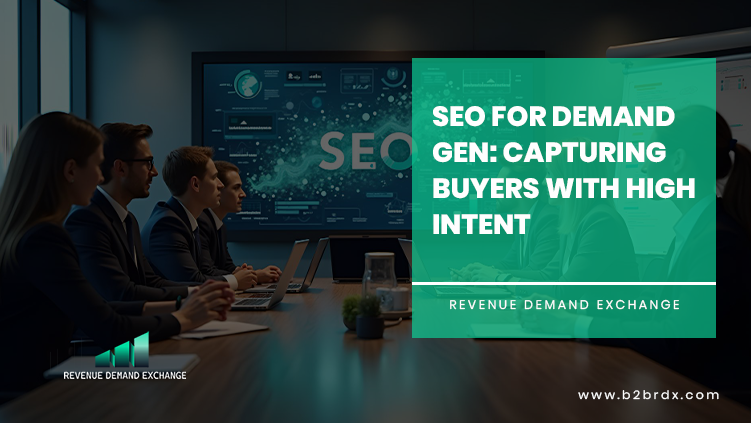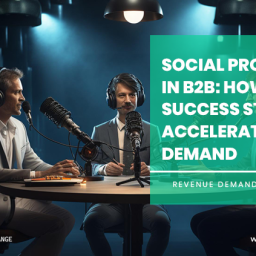SEO for Demand Gen: Capturing Buyers With High Intent

Introduction
Search Engine Optimization (SEO) and Demand Generation (Demand Gen) are no longer two independent fields in the ever-changing world of digital marketing; they are now two sides of the same coin. SEO helps generate demand by making sure that your brand, product, or service shows up at the proper time, when people are actively looking for solutions. But in a market full of noise and rivalry, it’s not enough to merely get people to visit your site; you also need to get high-intent buyers—those who are ready to act. This article talks about how organizations may use SEO and demand generation methods together to get, keep, and convert people who are ready to buy.
Understanding the Connection Between SEO and Demand Generation
The main goals of traditional SEO are to get higher rankings and more visitors. On the other side, demand generation’s goal is to get people to know about your product, get them interested, and build trust until they are ready to buy. When these two are in sync, SEO doesn’t simply bring in visits; it also brings in qualified leads.
SEO directly helps generate demand by focusing on keywords that show what the customer wants, making landing pages more likely to convert, and making useful content for every step of the buyer’s journey. It’s not enough to just be seen; you also need to be seen by the right people at the right moment.
Targeting High-Intent Keywords
Not every keyword is the same. Informational keywords like “what is email marketing” can bring in visitors, while high-intent phrases like “best email marketing software for startups” bring in those who are ready to buy.
Focusing on transactional and commercial intent keywords, which are terms and phrases that contain “buy,” “pricing,” “comparison,” or “reviews,” will help you get people who need something right away. For instance:
- Best CRM for small businesses
- Comparing the prices of SEO tools
- Best project management software for teams that work from home
Use keyword tools like Ahrefs, Semrush, or Google Keyword Planner to find search terms that show someone wants to buy something. Put keywords that have a good search volume and a good chance of converting at the top of your list.
Creating Content That Matches Buyer Intent
Content is what connects awareness and conversion. Your content strategy should match the different stages of the funnel to get high-intent buyers:
- Top of Funnel (TOFU): Make blog entries, guides, and infographics that teach people about your business to get the word out.
- Middle of Funnel (MOFU): Publish case studies, webinars, and in-depth comparisons that deal with problems.
- Bottom of Funnel (BOFU): Make landing pages, testimonials, demos, and product reviews that get people to buy.
People that are really interested in buying usually read BOFU and MOFU information. A comparison post like “HubSpot vs ActiveCampaign: Which Is Better for B2B?” or a tutorial like “How to Choose the Right Marketing Automation Tool” is directly aimed at people who are looking at their options.
It’s important to be consistent and relevant. Your material needs to not only rank well, but also fully answer the searcher’s question.
Optimizing for On-Page Conversions
Ranking isn’t the only thing you need to do to get high-intent buyers. Your site should be set up to turn visitors into customers as soon as they arrive. Pay attention to:
- Clear Calls to Action (CTAs): Use clear CTAs like “Get a Demo,” “Start Free Trial,” or “Request a Quote.”
- Fast page load speed: People with high intent often quit sites that load slowly.
- Mobile Optimization: Make sure that the mobile experience is smooth, since a lot of B2B buyers do their research on mobile devices.
- Trust Elements: Add testimonials, case studies, and security badges to your site to make it more trustworthy.
Making small changes to the UX and design can greatly increase the number of people who convert from organic traffic.
Building Topical Authority Through SEO Content Clusters
Websites that show topical authority—deep knowledge in a certain area—are now rewarded by search engines. This is a chance to make your brand a reputable source in your niche for demand generation.
Make groups of information around important subjects that are related to your product or service. For example, if your SaaS solution is all about automating sales, you may make a cluster around:
- Managing the sales pipeline
- Automating lead nurturing
- Integrations with CRM
Each subtopic links to a main “pillar page,” which tells Google that your site covers the topic in depth. This layout not only helps with rankings, but it also retains visitors on the page longer, which makes it more likely that they will convert.
Leveraging Search Intent Data for Personalized Campaigns
The intent data that SEO gives you is one of its most useful features. You can find patterns in how people buy things by looking at which keywords and pages bring in traffic.
For instance, if a blog article about “automated SMS campaigns” gets a lot of organic traffic, it means that there is a lot of demand for it. Then, based on that topic, you may set up a remarketing campaign, targeted LinkedIn advertisements, or an email process.
You can make targeted demand generation programs that nurture high-intent prospects more successfully by combining SEO data with CRM and marketing automation tools like HubSpot or ActiveCampaign.
Building Backlinks From Industry-Relevant Sources
High-quality backlinks from trusted websites not only help your SEO rankings, but they also make your brand more trustworthy, which is important for generating demand.
Instead of going after random connections, look for links from industry journals, specialist blogs, and partner websites. Guest writing, digital PR, or data-driven studies can help B2B companies get links and quality traffic.
For example, posting a paper called “2025 Trends in B2B Marketing Automation” might garner links from a lot of marketing sites and bring in targeted, high-intent visitors who are looking for answers.
Measuring SEO’s Impact on Demand Generation
To really connect SEO with demand generation, you need to look at more than just clicks and impressions. Check:
- Lead Quality: How many of the organic visits become Marketing Qualified Leads (MQLs)?
- Conversion Rate: Which blog posts or landing pages lead to sign-ups or requests for demos?
- Customer Acquisition Cost (CAC): Look at the difference between leads from SEO and leads from paid marketing.
- Pipeline Influence: How SEO content helps close deals through the pipeline.
Google Analytics 4, HubSpot, and Semrush are examples of tools that can give you a lot of information about how your SEO work affects demand generating results.
Conclusion
SEO for demand generation isn’t only about getting a higher rank; it’s also about putting your brand in front of the appropriate people at the right time. Businesses can leverage search exposure into measurable revenue growth by focusing on high-intent keywords, creating content that fits with the buyer journey, optimizing for conversions, and employing intent data.
SEO is the best technique to get high-intent buyers in a world when people have short attention spans and there is a lot of competition. When done right, SEO doesn’t only make people aware of your brand; it also provides opportunities, builds trust, and keeps demand for your business going.



